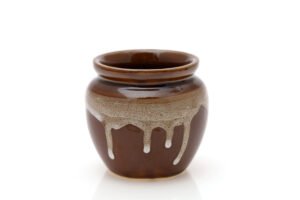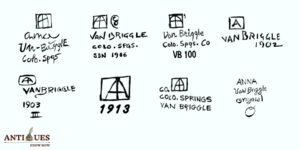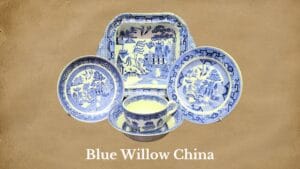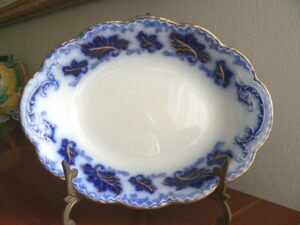Known for its vibrant, colorful patterns and different glazes, Hull pottery pieces can easily grab the attention of a vintage ceramic collector who can pay a hefty amount for them. But how would you know how much a Hull pottery item is worth?
In this guide, I’m going to decode all the crucial steps to assess the value of vintage Hull pottery by understanding its condition, markings, and patterns. There are also some clues to dating a Hull piece and finding out if it’s a real big deal!
The Brief Story of Hull Pottery
Hull pottery is the high-quality ceramics produced by Hull Pottery Company, established in Ohio in 1905 by Addis Emmet (A.E.) Hull. Starting with the common stoneware, dishware, and decorative tiles, the company launched its art pottery line in the 1920s.
After A.E. Hull’s death in 1930, his son, Addis E. Hull, Jr., took over the business. But he left soon to serve as Shawnee Pottery Company’s General Manager. Then, Gerald F. Watts took over the Hull Pottery Company. Then, unfortunately, a flood demolished the pottery plant in 1950.
But it was soon rebuilt, with J.B. Hull as the new manager. After running successfully for over 25 years, the company came under Henry Sulens after J.B. Hull passed away in 1978. It was finally shut down in 1986 due to union strikes and competition.
Hull pottery was quite popular for its unique colors and glazes during the early to late 20th century. It later branched out to make the Old Spice line, piggy banks, liquor bottles, lamps, and other pottery lines, which are highly collectible today, as per The Hull Pottery Association.
Assessing the Value of Vintage Hull Pottery
Vintage Hull art pottery pieces are usually worth around $20 to $100, with some rare, special items going up to $300 or even more. The final value of Hull pottery relies on how old and rare it is, what condition it is in, and, most importantly, what pattern it has.
Examine the Condition
Naturally, collectors look for pottery items that are free from any wear and tear and as close to their original condition as possible. So, observe carefully; if a Hull pottery piece has the following damages, it can lose its charm as well as worth:
- Large cracks
- Chipped edges or bottom
- Crazing on the surface
- Repaint & repair
- Too many stains or discoloration
For example, I found a marked Rose Fan in Hand Hull Pottery Vase in pristine condition on eBay that sold for $48. The same vase sold for only $25 in average condition with chipped edges.
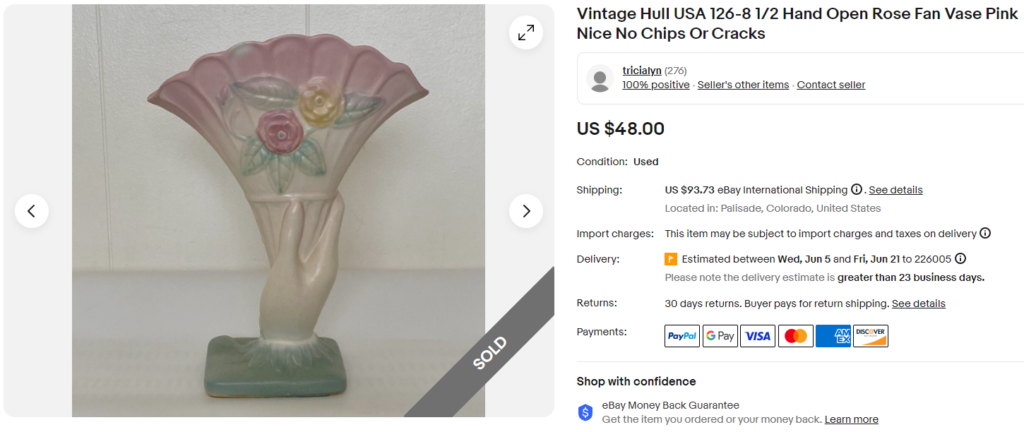
However, manufacturing errors, such as bubbles in the glaze, uneven glazing, or uneven shape with underglaze dents or bumps might make a Hull piece a true representation of hand-made pottery and, hence, valuable!
Check the Rarity & Demand of a Product
Knowing how rare a vintage Hull pottery piece is is extremely crucial for its valuation, as rare, uncommon pieces can sell for exceptional prices at an auction or sale. So, analyze past and ongoing sales to understand what pieces are fetching good returns, and which are rarely found.
The rarity of a Hull pottery piece corresponds to:
- Rare Pattern: Hull pieces with rare patterns that are hard to find today are highly valuable. The Little Red Riding Hood is one of Hull’s rarest patterns, no wonder this Spice Jar sells for around $200. Other rare patterns, like Tropicana, can also fetch good returns.

- Unusual Shape or Size: If a Hull pottery piece features a unique, unconventional shape or size, it can be a rare piece worth more than common Hull pieces. A perfect example of this is Hull’s “Bow Knot” wall pocket, which is generally valued at around $400 in excellent condition.
- Limited Edition Items: Hull pieces released as a part of a limited edition series or art line can be highly prized by collectors, just like this rare Hull Bicentennial Eagle Casserole that sold for $225!

- Prototypes and Test Pieces: Collectors often seek out Hull prototypes or sample pieces that didn’t make it into mass production. Calla Lily Hull pottery vase is one such test piece that was never mass-produced. After tracking the sales for a while, I finally found a 13.5-inch Calla Lily 2-handled vase that sold for $40 on eBay!
Identify the Patterns & Product Line
It’s no surprise that some specific Hull art pottery lines and patterns attract more collectors than others. For instance, art lines like “Magnolia” or “Wildflower” patterns are more popular among collectors and can command higher prices.
Some of the most popular Hull art pottery lines are
1. Little Red Riding Hood
The most popular art pottery line of Hull Pottery Co. is “Little Red Riding Hood,” released in 1943. It features the character from the European fairy tale of the same name. Recently, a rare cookie jar with this pattern sold for $95 in April.
2. Corky Pig Piggy Bank
This adorable piggy pank in pastel colors, produced in the 1940s, is a rare and highly desirable Hull pottery item. A Corky Pig Hull piggy bank in good condition sold for $170 on LiveAuctioneers.
3. Magnolia
The Magnolia pattern features hand-painted magnolia blossoms. Produced from the late 1930s to the 1950s, this pattern is quite popular among collectors, with a 13.5” vase selling for almost $120. Generally, it’s worth $20 – $60.

4. Tropicana
Hull’s Tropicana is tropical-green-trimmed white pottery displaying colorful Caribbean figures dancing, playing musical instruments, or swimming. It’s one of the rarest and most valuable Hull art pottery lines. A rare Tropicana (#51) Swimmer flower bowl planter is currently listed at almost $500 on eBay.
5. Woodland
Introduced in the 1940s, this nature-inspired pattern features a beautiful pink flower surrounded by flowing, hand-painted leaves. It’s one of the favorite Hull patterns among collectors, who can pay up to $80 to $100 for it.
6. Parchment & Pine
This pattern features an earthy cream parchment-like background with brown details, such as pines and green leaves. Hull Pottery made several items with this pattern, whose value ranges from $5 to $50.
7. Wildflower
Featuring hand-painted wildflowers, the Wildflower Hull art pottery line items can sell for up to $100 today. This Hull Art Pottery “W-18 12 1/2″ Wildflower Vase won a high bid of $98 on eBay.
8. Tokay
The Tokay Hull art pottery line included pieces with hand-painted grape clusters and vines. As per other factors, Tokay pottery is generally worth around $10 to $60.
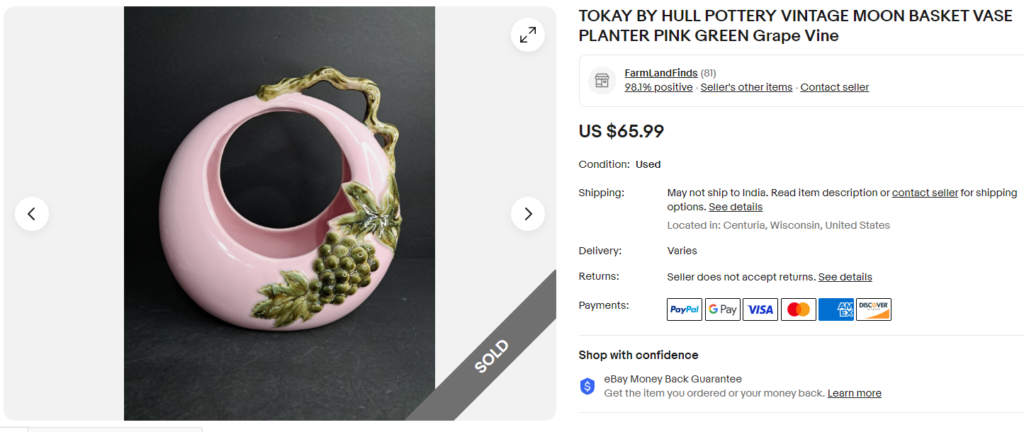
9. Continental
This is a mid-century modern two-tone design featuring solid colors with steaks along the height of the pottery items. With modern colors and shapes, Hull’s Continental novelty pieces are worth around $20 to $80.
10. Old Spice Product Line
In 1937, Hull Pottery Co. collaborated with Shulton Inc. to make shaving and cologne products, like shaving mugs and bottles, for men. These rare items can sell for up to $70 – $90 today, like this lotion bottle bought for $80 on eBay!
12. House ‘n’ Garden
Hull Pottery’s mainstay product line from the late 1960s to the 1980s was the House ‘n’ Garden line which included artistic kitchenware and florist ware in glossy glaze. Relatively newer, this line is worth less, around $20 to $30, rarely fetching more.
11. Oven Proof Line (Brown Drip)
Hull Pottery’s Oven Proof line is known for its glossy, deep brown glazing and drip-style accent on the edges. Designed to withstand the high temperatures of oven cooking, Hull’s oven-proof brown drip can be worth up to $200 or more, like this rare Hull Chip ‘n’ Dip Set with Sauce Bowl sold for $225.
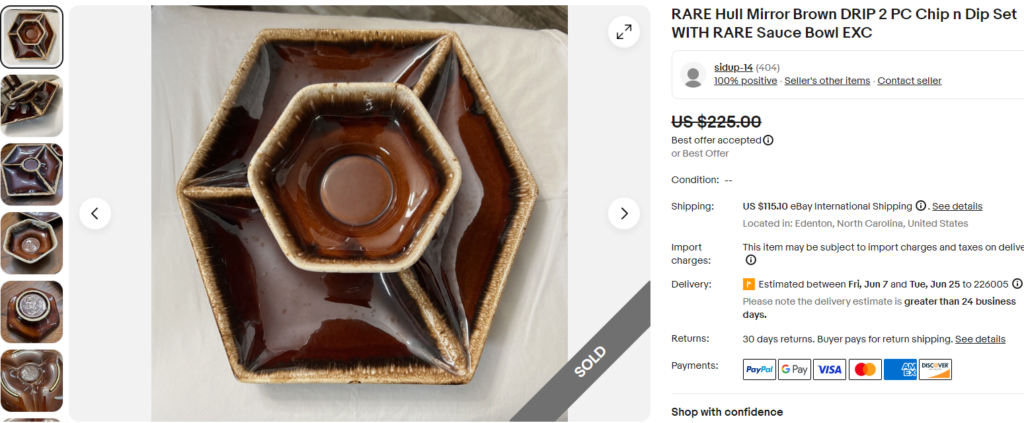
How to Identify & Date Vintage Hull Pottery
Naturally, Older Hull pottery pieces from the 1920s to 1950s are generally more valuable than the newer ones from the 1960s to ‘80s. For example, a vintage “Woodland” pattern bowl from the 1940s may be more valuable than a similar piece from the 1960s.
But how to identify how old a Hull piece is? Here are a few clues that will help.
- Generally, matte glazes in earthy tones were popular in and until the 1940s. Glossy-finished pottery pieces belong to the post-1950s era.
- Patterns like Tropicana, Parchment & Pine, Continental, Tokay, and Ebb Tide were introduced in the 1950s and 1960s.
- Oven-proof stoneware pieces mostly belong to the 1950s and 1960s.
In addition, the markings on the bottoms of Hull pottery pieces may also indicate the period they were manufactured.
The 1900s to 1920s Hull Pottery Marks
Most Hull pottery produced from 1905 until the 1920s features a simple encircled “H” logo, along with simple shape or mold number markings.

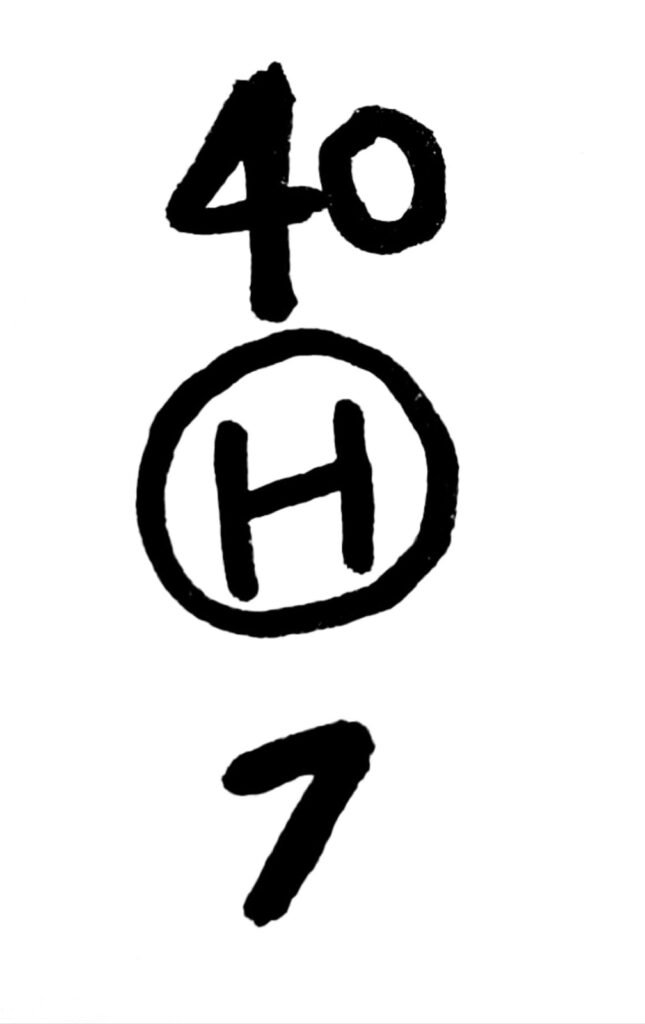
Some pieces may also have the “Hull Pottery,” “Hull U.S.A.” or “U.S.A./ Hull Art” embossment in a simple, block font and the size and shape numbers.
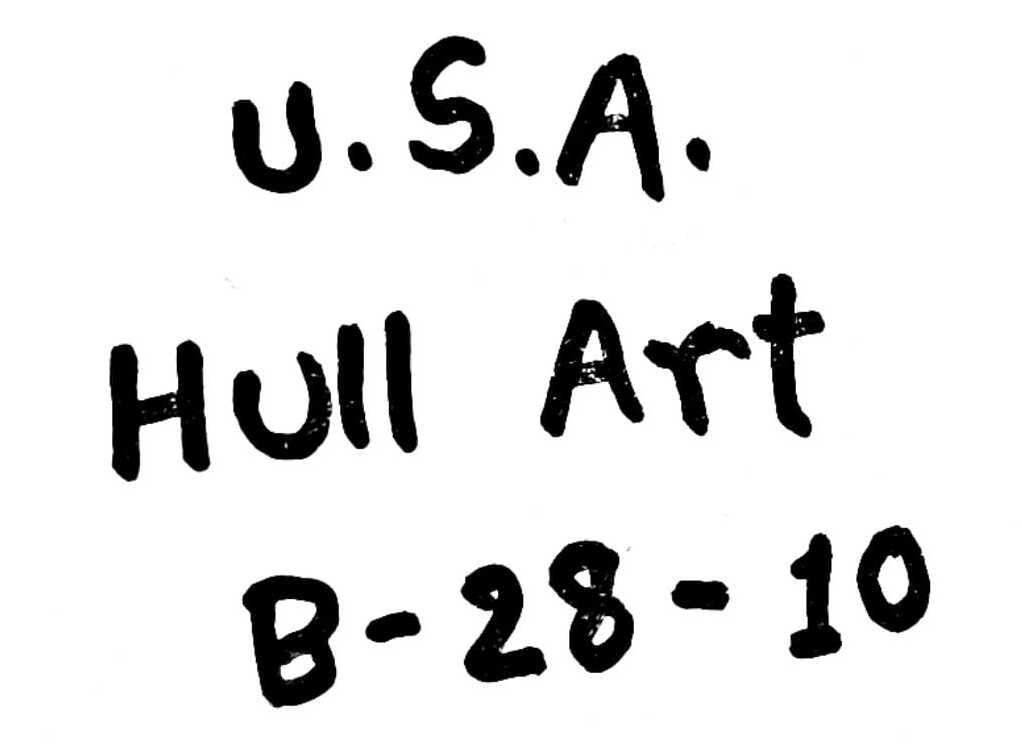
The 1930s to 1960s Hull Pottery Marks
In the 1930s Hull art pottery items began getting a stylized script “Hull” logo. You will also find the “U.S.A” mark in block letters, as well as the size and model number engraved at the base. This mark can be seen on many items made throughout the years until the 1960s.

1950s – 1960s Over Proof
The Brown stoneware ceramics manufactured by Hull company during the 1950s and 1960s can be identified by the cursive “Oven Proof” etching on the base, along with the “Hull ©” logo and “U.S.A.” mark. The later pieces may have a plain “Oven Proof” marking with numbering.

Apart from this, some special lines, like the Little Red Riding Hood and Corky Pig have their own specific markings, as shown below.
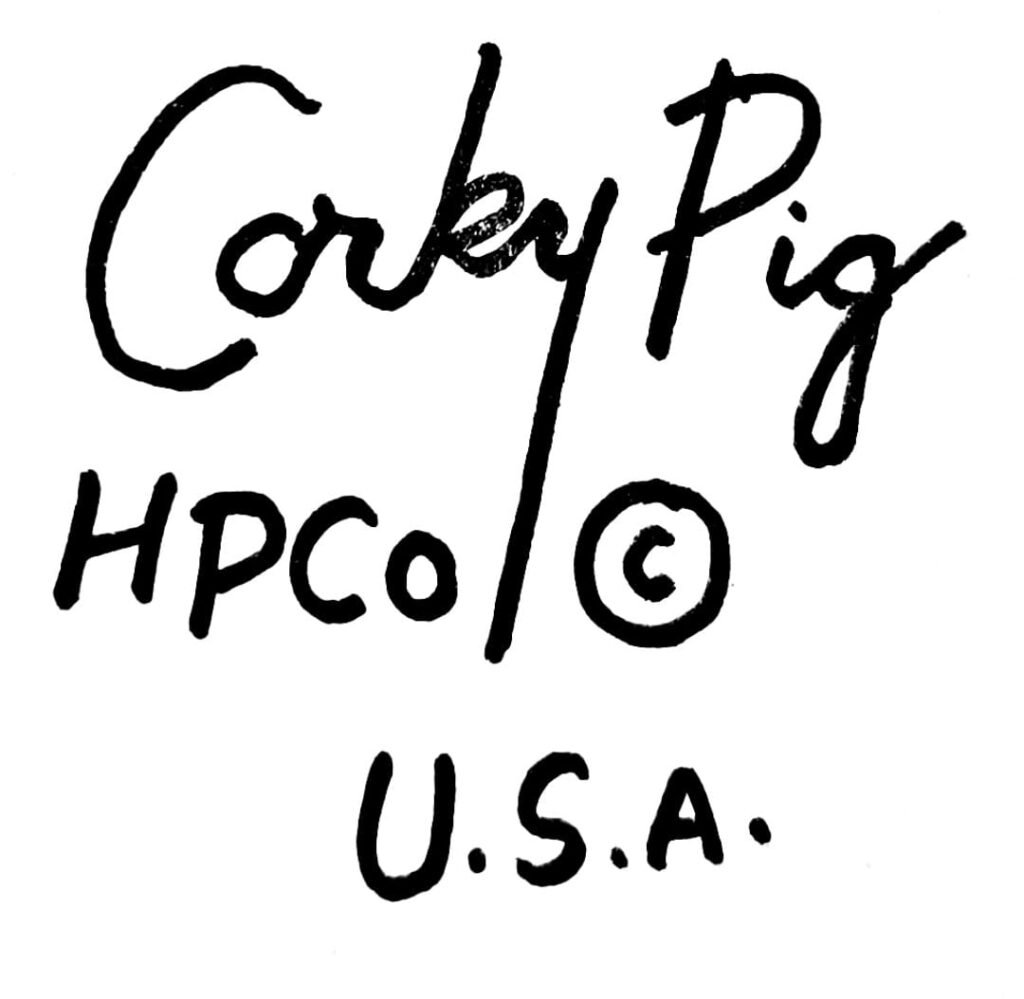
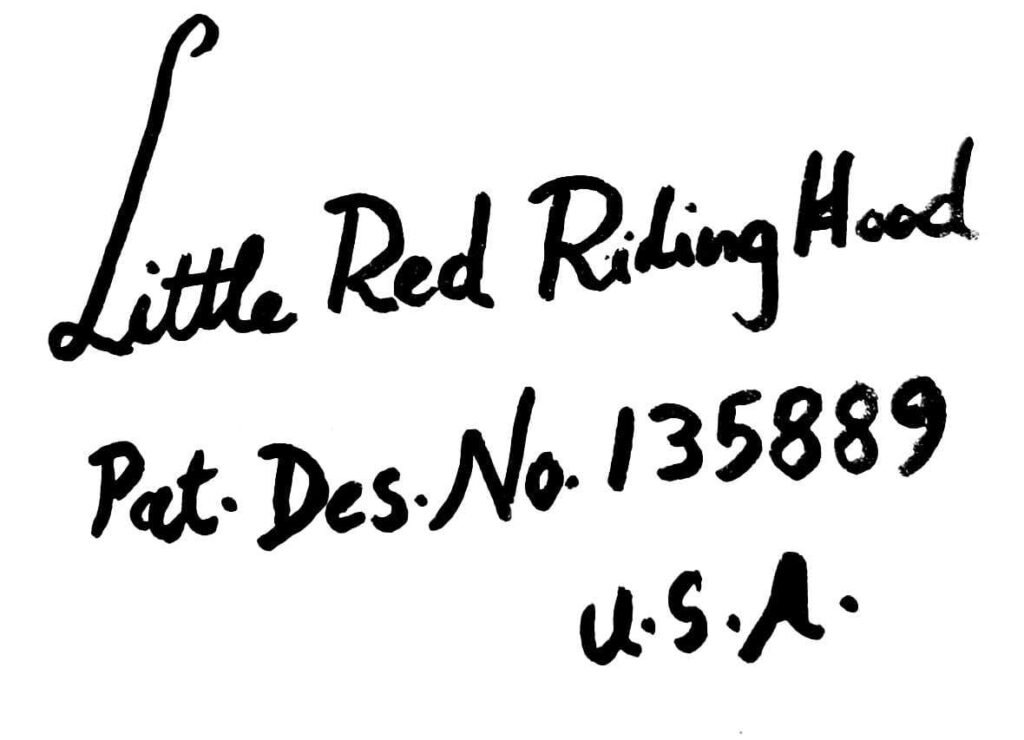
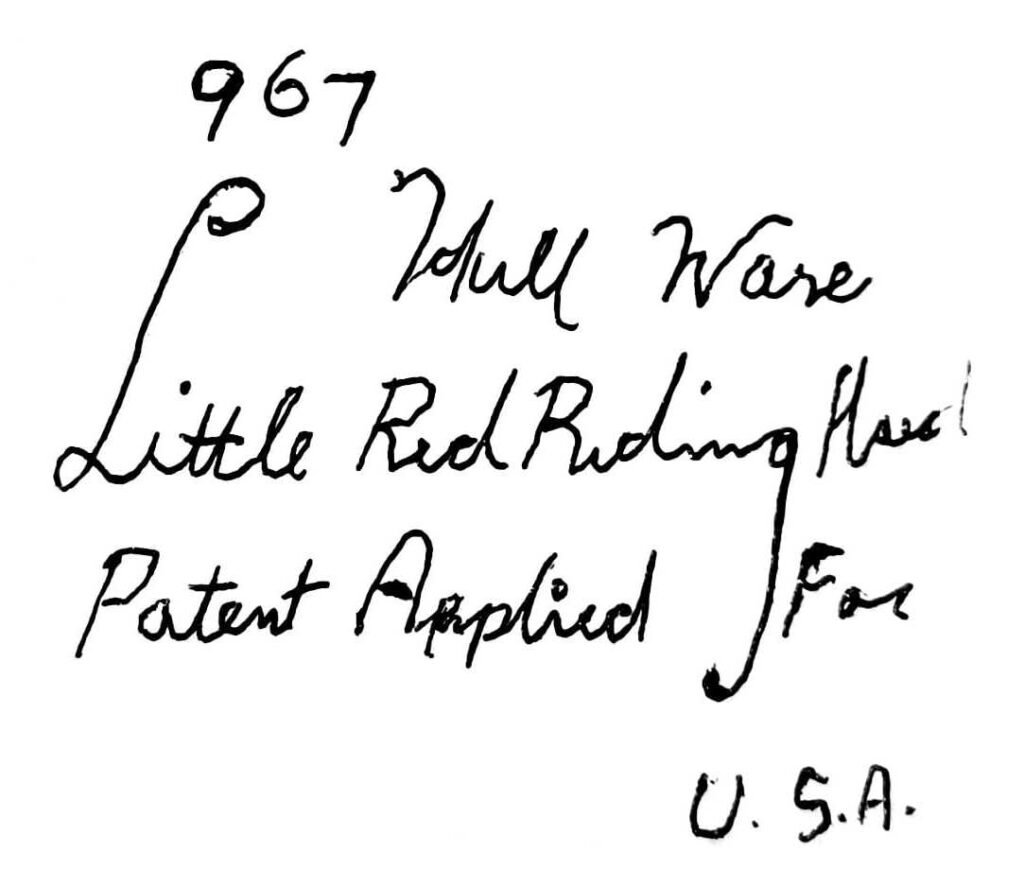
The latter Hull pottery items may also have a paper label glued to the bottom, along with or without the embossment or etched marks.
Spotting Fake or Reprodcued Hull Pottery Pieces
Once famous, everyone tried to copy the path, and the same happened with Hull’s artistic pieces. While Hull’s reproductions and fakes can be seemingly convincing, several telltale signs will help you separate the genuine articles from the wannabes.
- Smaller & Lighter: Reproduced Hull pottery is generally made using a mold made with an existing item. So. reproduced pieces are slightly smaller and lighter than the original model. So, compare your Hull art piece with an existing item of the same type and pattern.
- Varying Bottom Markings: Compare the marking on your piece with an authentic piece with the same pattern. If you notice differences in the Hull Pottery logo and font, it’s likely a red flag, a fake Hull piece.
- Different Colors & Glazes: The colors of fake or reproduced Hull pottery pieces do not generally resemble the original colors of a given art pottery line. Besides, uneven glazing, shoddy painting, and other visible imperfections indicate it’s a reproduction or fake.
- Unusual Patterns: If a Hull pottery piece claims to be from a specific pattern or art line but doesn’t really resemble the details of known examples, it could be a fake.
Identifying, dating, and valuing an old Hull pottery piece is a lot easier when you know what exactly to look for. So, use this guide to analyze any Hull ceramic item you want to buy or sell and find the best price for it. You can learn the valuation of other iconic potteries, such as Roseville and Frankoma Pottery!
Note: This article is intended for informational, educational, and entertainment purposes only. Some images are illustrative and may not represent actual brands, products, or related entities. All trademarks, product names, brand logos, packaging, and other intellectual property referenced remain the exclusive property of their respective owners. Any brand mentions or references are provided solely for descriptive and educational context and do not imply any formal or commercial association.

